ITECH7402 - Analyzing Ethical Dilemmas & SFIA Career Plan in IT
VerifiedAdded on 2023/06/08
|13
|1998
|97
Report
AI Summary
This report analyzes a case study involving an ethical dilemma within an IT organization, where a bug in a new operating system was knowingly ignored before product launch. The report identifies key stakeholders and discusses the impact of the decision on them, referencing the ACS code of professional conduct and relevant theories of ethical philosophy. It explores the conflict between meeting deadlines and ensuring product quality, highlighting the importance of prioritizing public interest and professional integrity. Furthermore, the report includes a career plan using the SFIA framework, outlining the skills and competencies required for various IT roles and emphasizing the need for continuous professional development. The conclusion underscores the significance of ethical decision-making in IT and its potential consequences for both the organization and its stakeholders. Desklib provides this assignment solution and many more resources to help students.
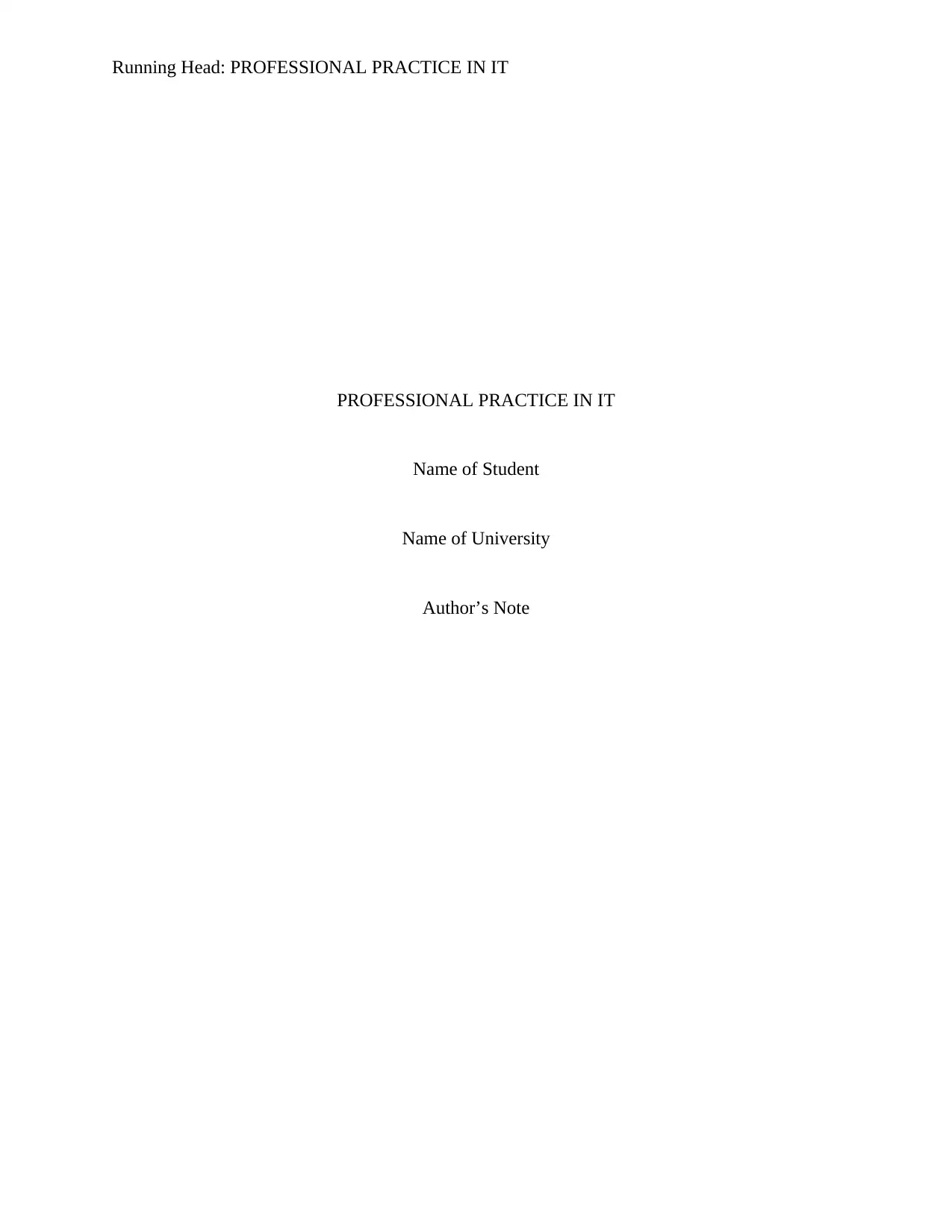
Running Head: PROFESSIONAL PRACTICE IN IT
PROFESSIONAL PRACTICE IN IT
Name of Student
Name of University
Author’s Note
PROFESSIONAL PRACTICE IN IT
Name of Student
Name of University
Author’s Note
Secure Best Marks with AI Grader
Need help grading? Try our AI Grader for instant feedback on your assignments.
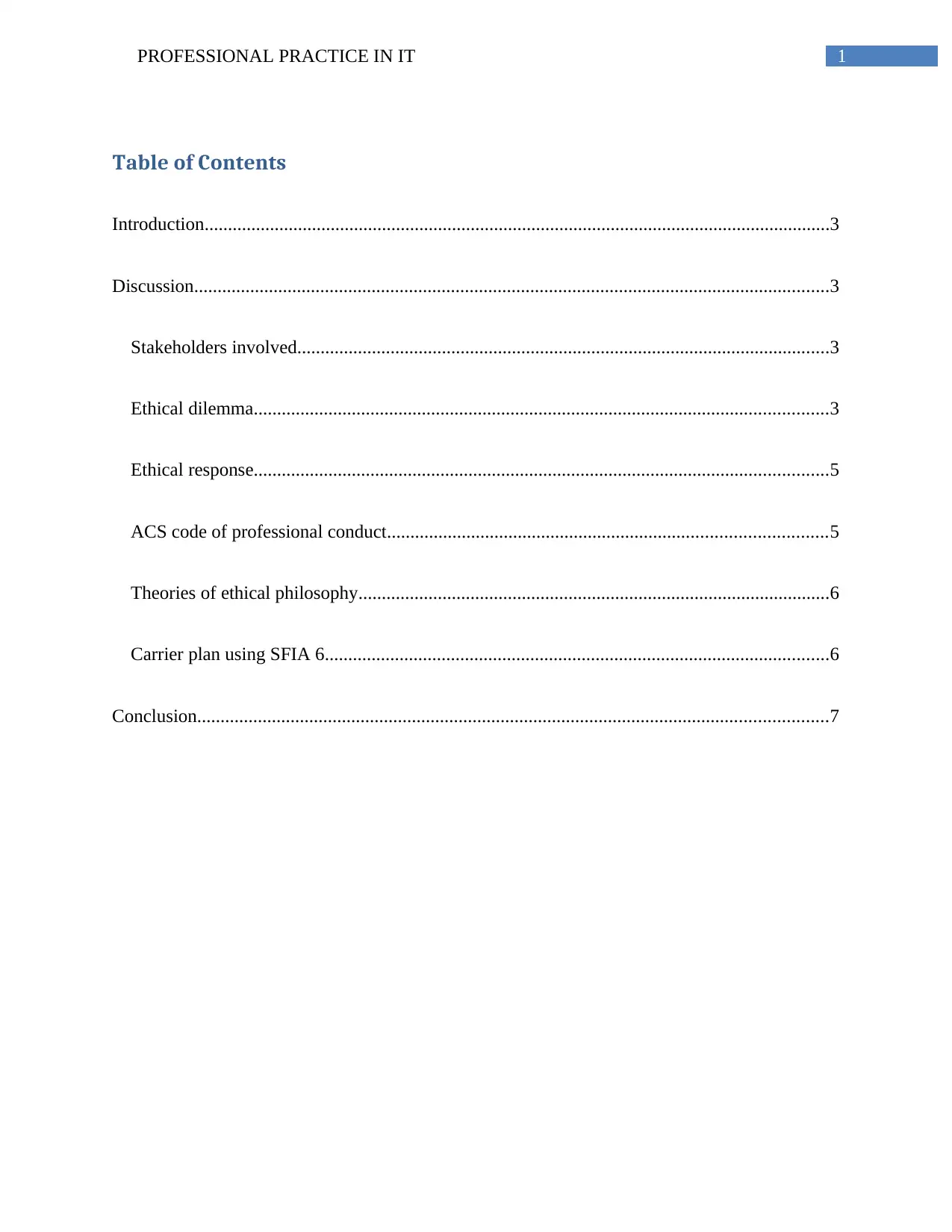
1PROFESSIONAL PRACTICE IN IT
Table of Contents
Introduction......................................................................................................................................3
Discussion........................................................................................................................................3
Stakeholders involved..................................................................................................................3
Ethical dilemma...........................................................................................................................3
Ethical response...........................................................................................................................5
ACS code of professional conduct..............................................................................................5
Theories of ethical philosophy.....................................................................................................6
Carrier plan using SFIA 6............................................................................................................6
Conclusion.......................................................................................................................................7
Table of Contents
Introduction......................................................................................................................................3
Discussion........................................................................................................................................3
Stakeholders involved..................................................................................................................3
Ethical dilemma...........................................................................................................................3
Ethical response...........................................................................................................................5
ACS code of professional conduct..............................................................................................5
Theories of ethical philosophy.....................................................................................................6
Carrier plan using SFIA 6............................................................................................................6
Conclusion.......................................................................................................................................7
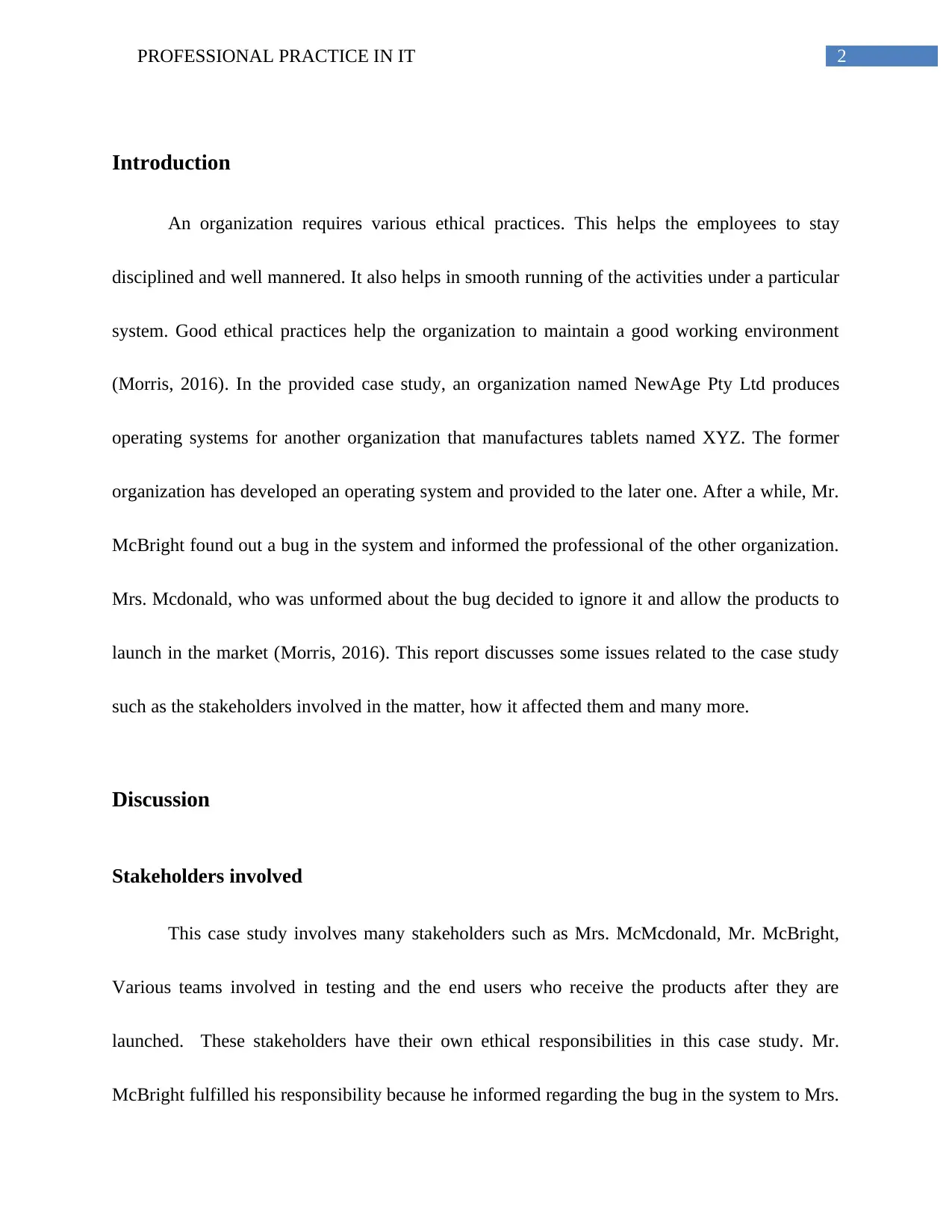
2PROFESSIONAL PRACTICE IN IT
Introduction
An organization requires various ethical practices. This helps the employees to stay
disciplined and well mannered. It also helps in smooth running of the activities under a particular
system. Good ethical practices help the organization to maintain a good working environment
(Morris, 2016). In the provided case study, an organization named NewAge Pty Ltd produces
operating systems for another organization that manufactures tablets named XYZ. The former
organization has developed an operating system and provided to the later one. After a while, Mr.
McBright found out a bug in the system and informed the professional of the other organization.
Mrs. Mcdonald, who was unformed about the bug decided to ignore it and allow the products to
launch in the market (Morris, 2016). This report discusses some issues related to the case study
such as the stakeholders involved in the matter, how it affected them and many more.
Discussion
Stakeholders involved
This case study involves many stakeholders such as Mrs. McMcdonald, Mr. McBright,
Various teams involved in testing and the end users who receive the products after they are
launched. These stakeholders have their own ethical responsibilities in this case study. Mr.
McBright fulfilled his responsibility because he informed regarding the bug in the system to Mrs.
Introduction
An organization requires various ethical practices. This helps the employees to stay
disciplined and well mannered. It also helps in smooth running of the activities under a particular
system. Good ethical practices help the organization to maintain a good working environment
(Morris, 2016). In the provided case study, an organization named NewAge Pty Ltd produces
operating systems for another organization that manufactures tablets named XYZ. The former
organization has developed an operating system and provided to the later one. After a while, Mr.
McBright found out a bug in the system and informed the professional of the other organization.
Mrs. Mcdonald, who was unformed about the bug decided to ignore it and allow the products to
launch in the market (Morris, 2016). This report discusses some issues related to the case study
such as the stakeholders involved in the matter, how it affected them and many more.
Discussion
Stakeholders involved
This case study involves many stakeholders such as Mrs. McMcdonald, Mr. McBright,
Various teams involved in testing and the end users who receive the products after they are
launched. These stakeholders have their own ethical responsibilities in this case study. Mr.
McBright fulfilled his responsibility because he informed regarding the bug in the system to Mrs.
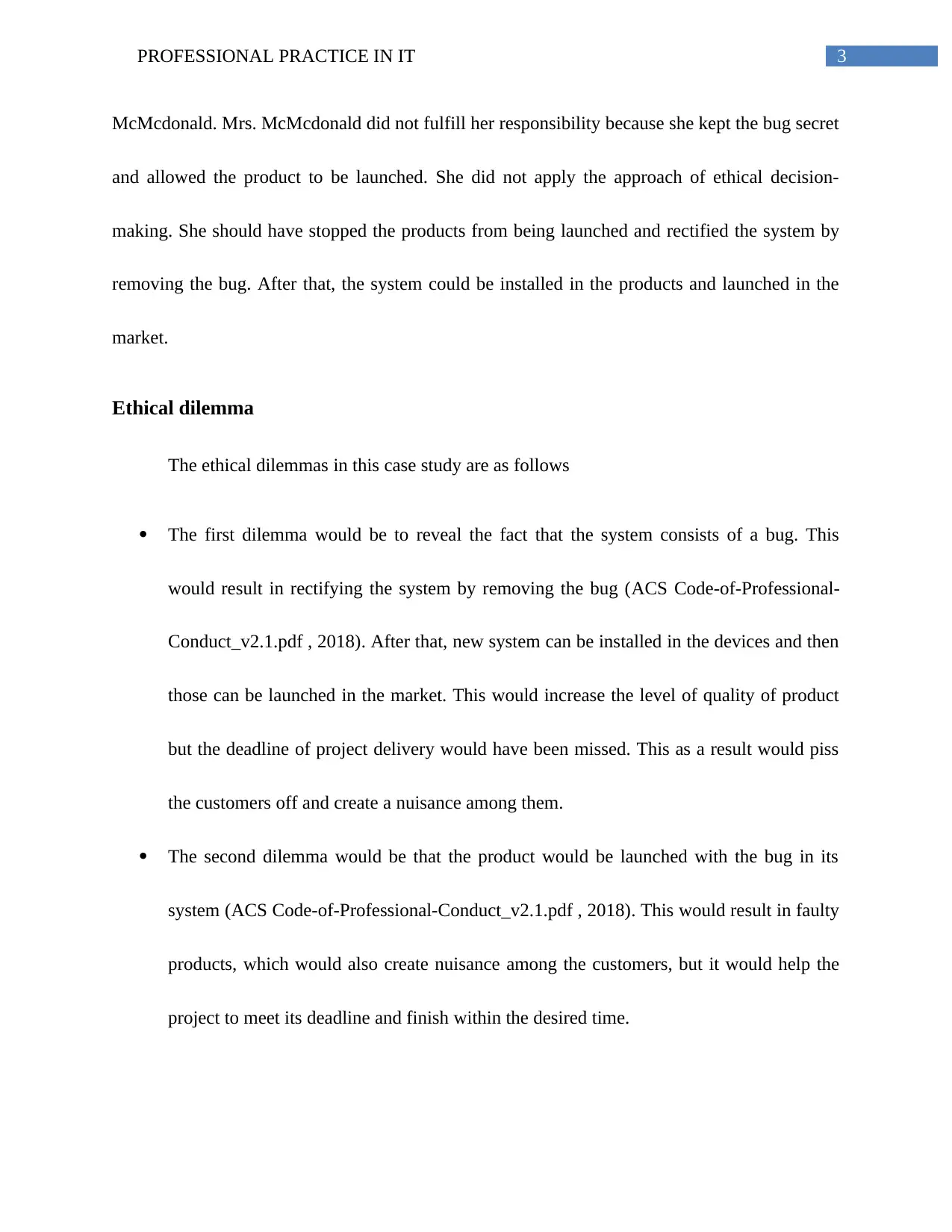
3PROFESSIONAL PRACTICE IN IT
McMcdonald. Mrs. McMcdonald did not fulfill her responsibility because she kept the bug secret
and allowed the product to be launched. She did not apply the approach of ethical decision-
making. She should have stopped the products from being launched and rectified the system by
removing the bug. After that, the system could be installed in the products and launched in the
market.
Ethical dilemma
The ethical dilemmas in this case study are as follows
The first dilemma would be to reveal the fact that the system consists of a bug. This
would result in rectifying the system by removing the bug (ACS Code-of-Professional-
Conduct_v2.1.pdf , 2018). After that, new system can be installed in the devices and then
those can be launched in the market. This would increase the level of quality of product
but the deadline of project delivery would have been missed. This as a result would piss
the customers off and create a nuisance among them.
The second dilemma would be that the product would be launched with the bug in its
system (ACS Code-of-Professional-Conduct_v2.1.pdf , 2018). This would result in faulty
products, which would also create nuisance among the customers, but it would help the
project to meet its deadline and finish within the desired time.
McMcdonald. Mrs. McMcdonald did not fulfill her responsibility because she kept the bug secret
and allowed the product to be launched. She did not apply the approach of ethical decision-
making. She should have stopped the products from being launched and rectified the system by
removing the bug. After that, the system could be installed in the products and launched in the
market.
Ethical dilemma
The ethical dilemmas in this case study are as follows
The first dilemma would be to reveal the fact that the system consists of a bug. This
would result in rectifying the system by removing the bug (ACS Code-of-Professional-
Conduct_v2.1.pdf , 2018). After that, new system can be installed in the devices and then
those can be launched in the market. This would increase the level of quality of product
but the deadline of project delivery would have been missed. This as a result would piss
the customers off and create a nuisance among them.
The second dilemma would be that the product would be launched with the bug in its
system (ACS Code-of-Professional-Conduct_v2.1.pdf , 2018). This would result in faulty
products, which would also create nuisance among the customers, but it would help the
project to meet its deadline and finish within the desired time.
Secure Best Marks with AI Grader
Need help grading? Try our AI Grader for instant feedback on your assignments.
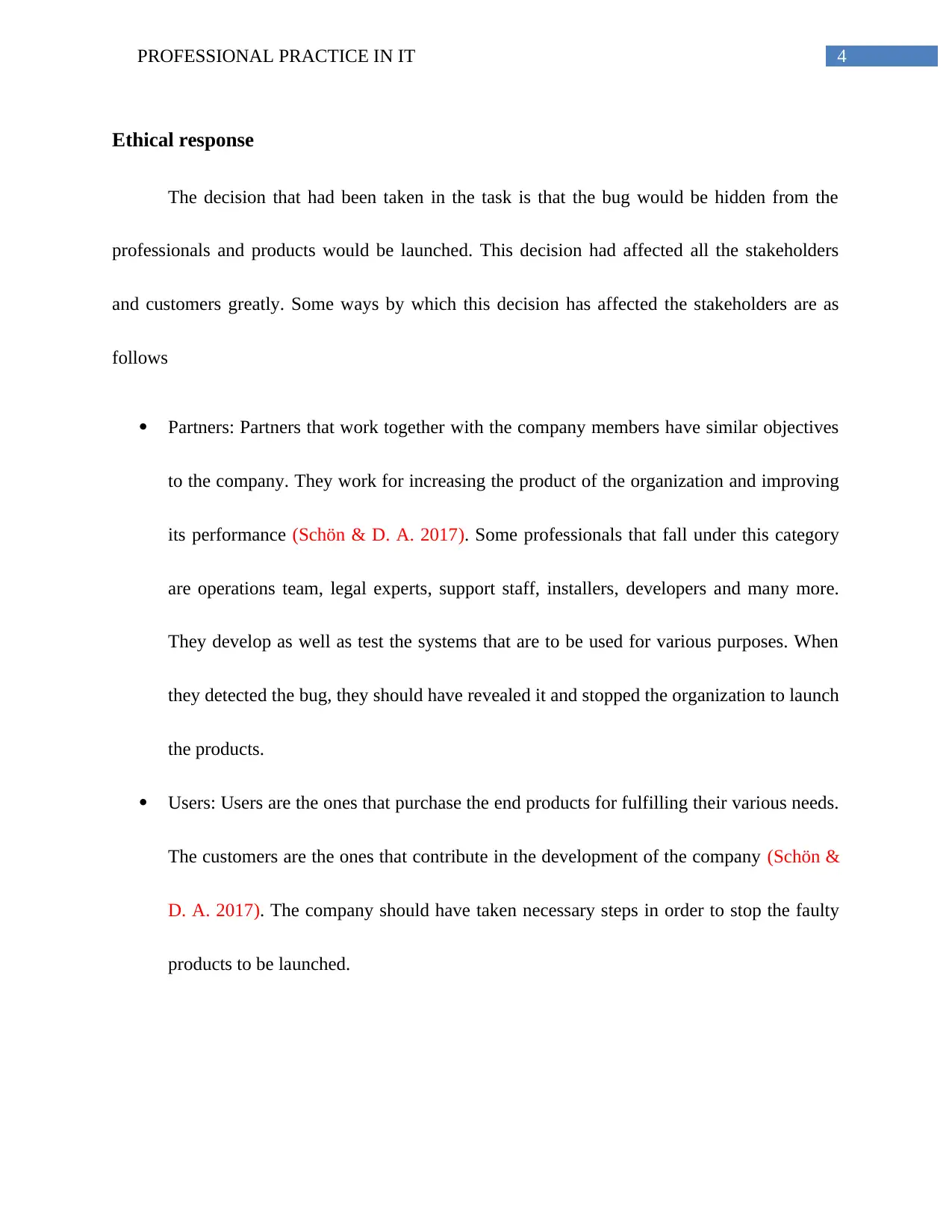
4PROFESSIONAL PRACTICE IN IT
Ethical response
The decision that had been taken in the task is that the bug would be hidden from the
professionals and products would be launched. This decision had affected all the stakeholders
and customers greatly. Some ways by which this decision has affected the stakeholders are as
follows
Partners: Partners that work together with the company members have similar objectives
to the company. They work for increasing the product of the organization and improving
its performance (Schön & D. A. 2017). Some professionals that fall under this category
are operations team, legal experts, support staff, installers, developers and many more.
They develop as well as test the systems that are to be used for various purposes. When
they detected the bug, they should have revealed it and stopped the organization to launch
the products.
Users: Users are the ones that purchase the end products for fulfilling their various needs.
The customers are the ones that contribute in the development of the company (Schön &
D. A. 2017). The company should have taken necessary steps in order to stop the faulty
products to be launched.
Ethical response
The decision that had been taken in the task is that the bug would be hidden from the
professionals and products would be launched. This decision had affected all the stakeholders
and customers greatly. Some ways by which this decision has affected the stakeholders are as
follows
Partners: Partners that work together with the company members have similar objectives
to the company. They work for increasing the product of the organization and improving
its performance (Schön & D. A. 2017). Some professionals that fall under this category
are operations team, legal experts, support staff, installers, developers and many more.
They develop as well as test the systems that are to be used for various purposes. When
they detected the bug, they should have revealed it and stopped the organization to launch
the products.
Users: Users are the ones that purchase the end products for fulfilling their various needs.
The customers are the ones that contribute in the development of the company (Schön &
D. A. 2017). The company should have taken necessary steps in order to stop the faulty
products to be launched.
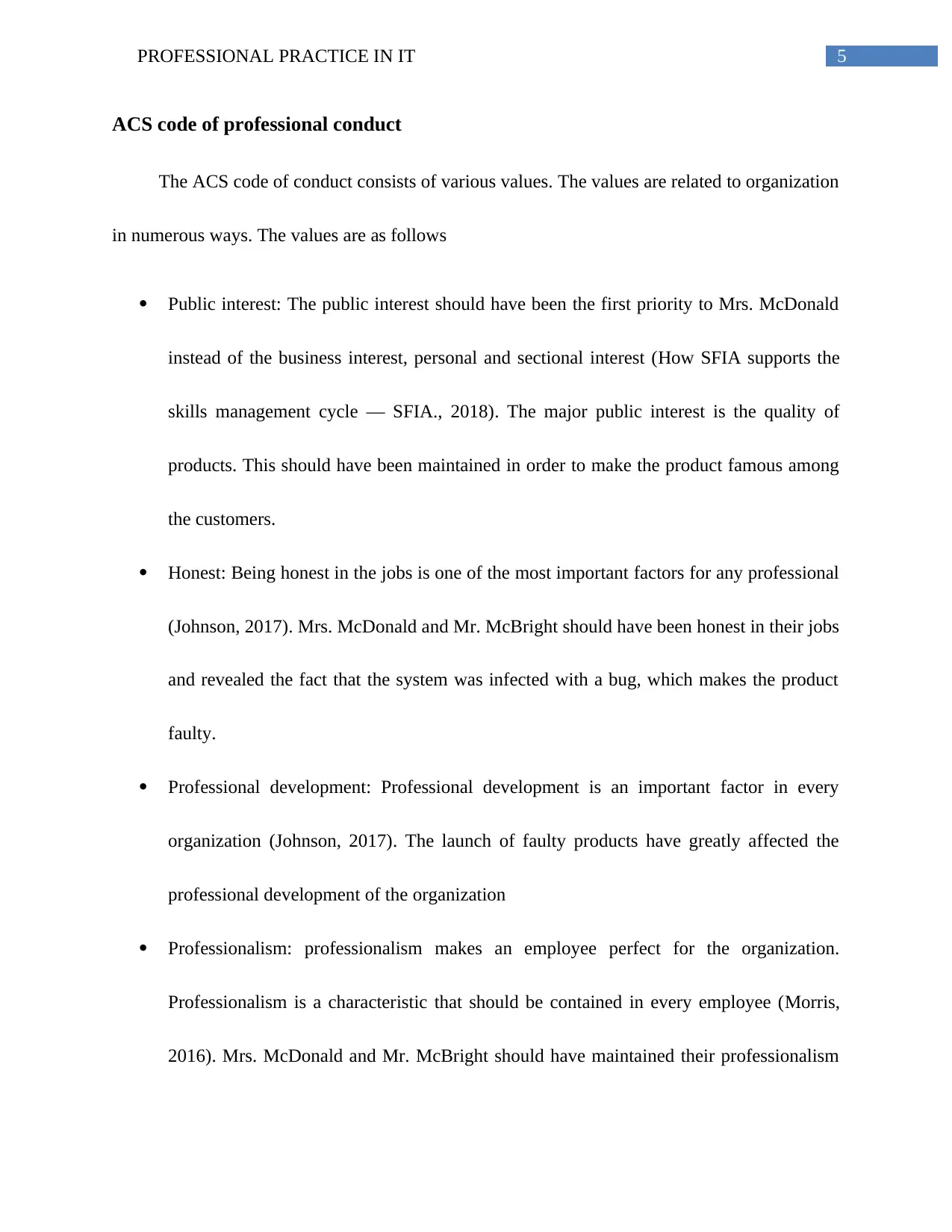
5PROFESSIONAL PRACTICE IN IT
ACS code of professional conduct
The ACS code of conduct consists of various values. The values are related to organization
in numerous ways. The values are as follows
Public interest: The public interest should have been the first priority to Mrs. McDonald
instead of the business interest, personal and sectional interest (How SFIA supports the
skills management cycle — SFIA., 2018). The major public interest is the quality of
products. This should have been maintained in order to make the product famous among
the customers.
Honest: Being honest in the jobs is one of the most important factors for any professional
(Johnson, 2017). Mrs. McDonald and Mr. McBright should have been honest in their jobs
and revealed the fact that the system was infected with a bug, which makes the product
faulty.
Professional development: Professional development is an important factor in every
organization (Johnson, 2017). The launch of faulty products have greatly affected the
professional development of the organization
Professionalism: professionalism makes an employee perfect for the organization.
Professionalism is a characteristic that should be contained in every employee (Morris,
2016). Mrs. McDonald and Mr. McBright should have maintained their professionalism
ACS code of professional conduct
The ACS code of conduct consists of various values. The values are related to organization
in numerous ways. The values are as follows
Public interest: The public interest should have been the first priority to Mrs. McDonald
instead of the business interest, personal and sectional interest (How SFIA supports the
skills management cycle — SFIA., 2018). The major public interest is the quality of
products. This should have been maintained in order to make the product famous among
the customers.
Honest: Being honest in the jobs is one of the most important factors for any professional
(Johnson, 2017). Mrs. McDonald and Mr. McBright should have been honest in their jobs
and revealed the fact that the system was infected with a bug, which makes the product
faulty.
Professional development: Professional development is an important factor in every
organization (Johnson, 2017). The launch of faulty products have greatly affected the
professional development of the organization
Professionalism: professionalism makes an employee perfect for the organization.
Professionalism is a characteristic that should be contained in every employee (Morris,
2016). Mrs. McDonald and Mr. McBright should have maintained their professionalism
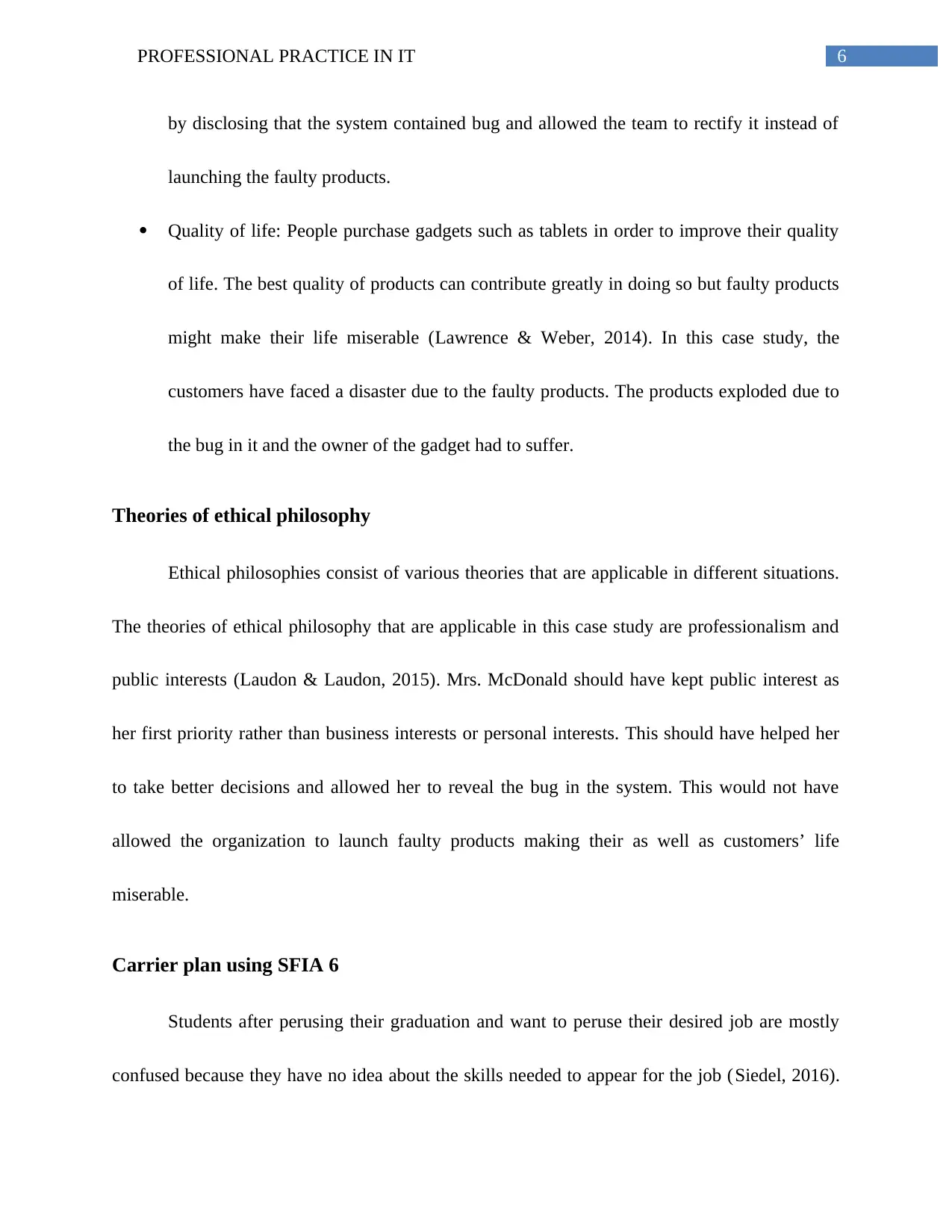
6PROFESSIONAL PRACTICE IN IT
by disclosing that the system contained bug and allowed the team to rectify it instead of
launching the faulty products.
Quality of life: People purchase gadgets such as tablets in order to improve their quality
of life. The best quality of products can contribute greatly in doing so but faulty products
might make their life miserable (Lawrence & Weber, 2014). In this case study, the
customers have faced a disaster due to the faulty products. The products exploded due to
the bug in it and the owner of the gadget had to suffer.
Theories of ethical philosophy
Ethical philosophies consist of various theories that are applicable in different situations.
The theories of ethical philosophy that are applicable in this case study are professionalism and
public interests (Laudon & Laudon, 2015). Mrs. McDonald should have kept public interest as
her first priority rather than business interests or personal interests. This should have helped her
to take better decisions and allowed her to reveal the bug in the system. This would not have
allowed the organization to launch faulty products making their as well as customers’ life
miserable.
Carrier plan using SFIA 6
Students after perusing their graduation and want to peruse their desired job are mostly
confused because they have no idea about the skills needed to appear for the job (Siedel, 2016).
by disclosing that the system contained bug and allowed the team to rectify it instead of
launching the faulty products.
Quality of life: People purchase gadgets such as tablets in order to improve their quality
of life. The best quality of products can contribute greatly in doing so but faulty products
might make their life miserable (Lawrence & Weber, 2014). In this case study, the
customers have faced a disaster due to the faulty products. The products exploded due to
the bug in it and the owner of the gadget had to suffer.
Theories of ethical philosophy
Ethical philosophies consist of various theories that are applicable in different situations.
The theories of ethical philosophy that are applicable in this case study are professionalism and
public interests (Laudon & Laudon, 2015). Mrs. McDonald should have kept public interest as
her first priority rather than business interests or personal interests. This should have helped her
to take better decisions and allowed her to reveal the bug in the system. This would not have
allowed the organization to launch faulty products making their as well as customers’ life
miserable.
Carrier plan using SFIA 6
Students after perusing their graduation and want to peruse their desired job are mostly
confused because they have no idea about the skills needed to appear for the job (Siedel, 2016).
Paraphrase This Document
Need a fresh take? Get an instant paraphrase of this document with our AI Paraphraser
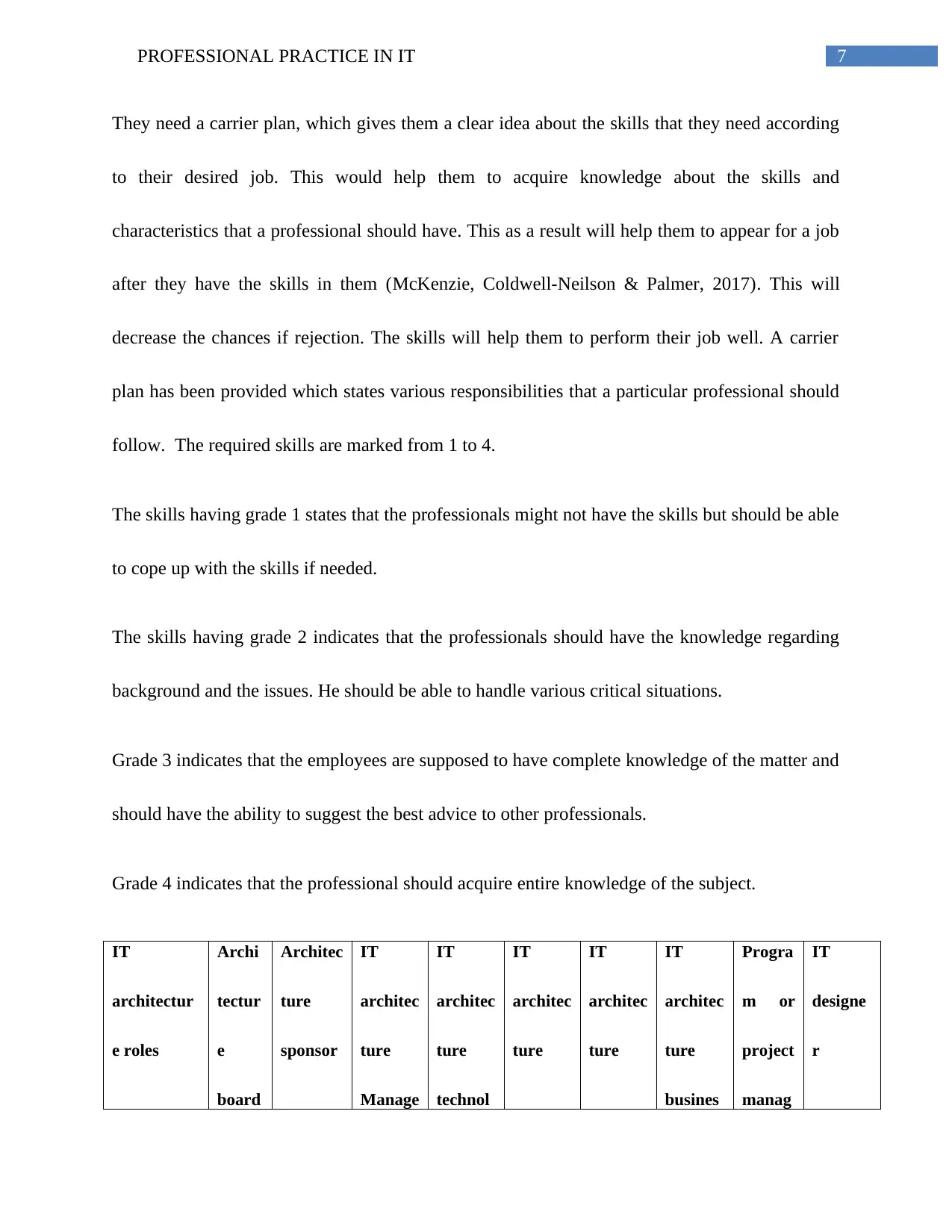
7PROFESSIONAL PRACTICE IN IT
They need a carrier plan, which gives them a clear idea about the skills that they need according
to their desired job. This would help them to acquire knowledge about the skills and
characteristics that a professional should have. This as a result will help them to appear for a job
after they have the skills in them (McKenzie, Coldwell-Neilson & Palmer, 2017). This will
decrease the chances if rejection. The skills will help them to perform their job well. A carrier
plan has been provided which states various responsibilities that a particular professional should
follow. The required skills are marked from 1 to 4.
The skills having grade 1 states that the professionals might not have the skills but should be able
to cope up with the skills if needed.
The skills having grade 2 indicates that the professionals should have the knowledge regarding
background and the issues. He should be able to handle various critical situations.
Grade 3 indicates that the employees are supposed to have complete knowledge of the matter and
should have the ability to suggest the best advice to other professionals.
Grade 4 indicates that the professional should acquire entire knowledge of the subject.
IT
architectur
e roles
Archi
tectur
e
board
Architec
ture
sponsor
IT
architec
ture
Manage
IT
architec
ture
technol
IT
architec
ture
IT
architec
ture
IT
architec
ture
busines
Progra
m or
project
manag
IT
designe
r
They need a carrier plan, which gives them a clear idea about the skills that they need according
to their desired job. This would help them to acquire knowledge about the skills and
characteristics that a professional should have. This as a result will help them to appear for a job
after they have the skills in them (McKenzie, Coldwell-Neilson & Palmer, 2017). This will
decrease the chances if rejection. The skills will help them to perform their job well. A carrier
plan has been provided which states various responsibilities that a particular professional should
follow. The required skills are marked from 1 to 4.
The skills having grade 1 states that the professionals might not have the skills but should be able
to cope up with the skills if needed.
The skills having grade 2 indicates that the professionals should have the knowledge regarding
background and the issues. He should be able to handle various critical situations.
Grade 3 indicates that the employees are supposed to have complete knowledge of the matter and
should have the ability to suggest the best advice to other professionals.
Grade 4 indicates that the professional should acquire entire knowledge of the subject.
IT
architectur
e roles
Archi
tectur
e
board
Architec
ture
sponsor
IT
architec
ture
Manage
IT
architec
ture
technol
IT
architec
ture
IT
architec
ture
IT
architec
ture
busines
Progra
m or
project
manag
IT
designe
r
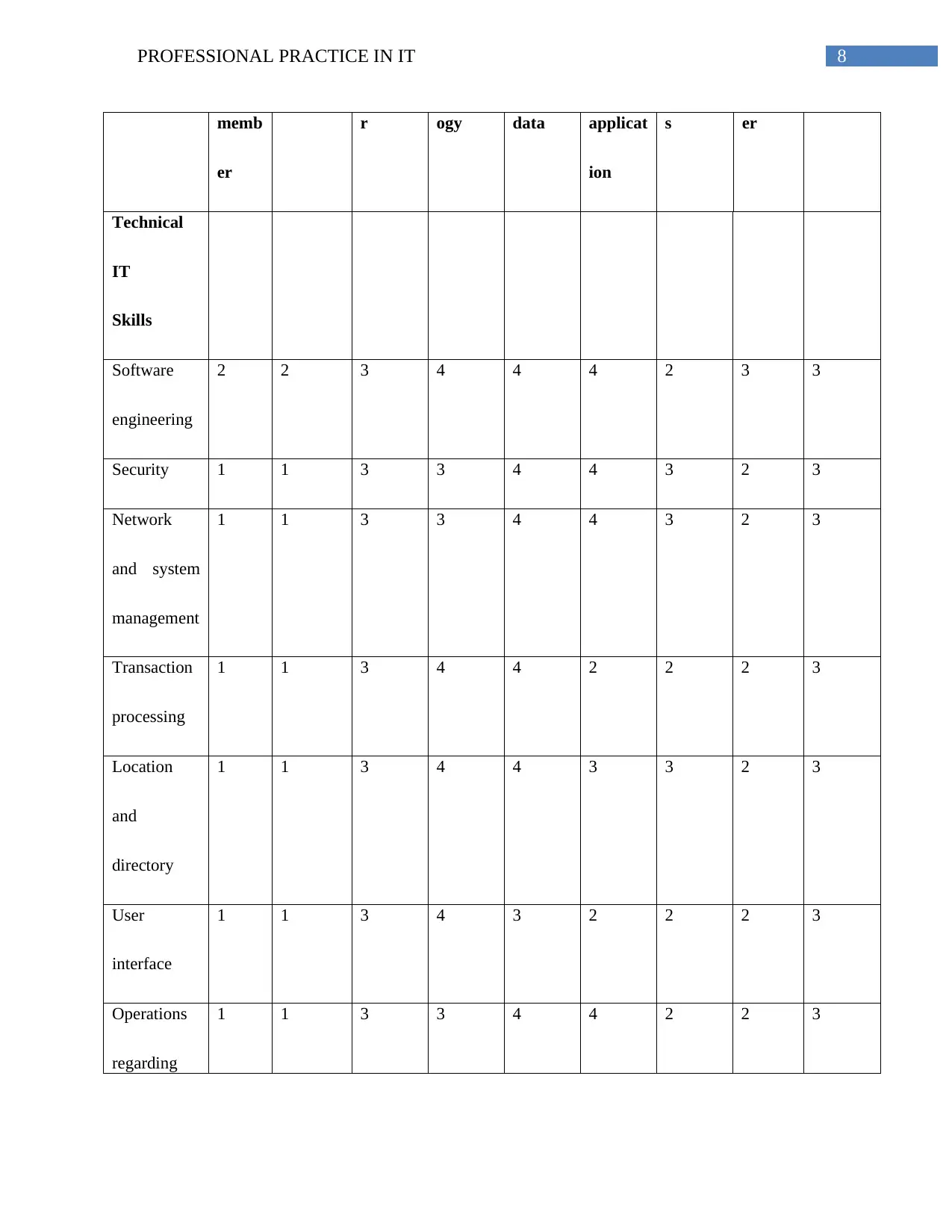
8PROFESSIONAL PRACTICE IN IT
memb
er
r ogy data applicat
ion
s er
Technical
IT
Skills
Software
engineering
2 2 3 4 4 4 2 3 3
Security 1 1 3 3 4 4 3 2 3
Network
and system
management
1 1 3 3 4 4 3 2 3
Transaction
processing
1 1 3 4 4 2 2 2 3
Location
and
directory
1 1 3 4 4 3 3 2 3
User
interface
1 1 3 4 3 2 2 2 3
Operations
regarding
1 1 3 3 4 4 2 2 3
memb
er
r ogy data applicat
ion
s er
Technical
IT
Skills
Software
engineering
2 2 3 4 4 4 2 3 3
Security 1 1 3 3 4 4 3 2 3
Network
and system
management
1 1 3 3 4 4 3 2 3
Transaction
processing
1 1 3 4 4 2 2 2 3
Location
and
directory
1 1 3 4 4 3 3 2 3
User
interface
1 1 3 4 3 2 2 2 3
Operations
regarding
1 1 3 3 4 4 2 2 3
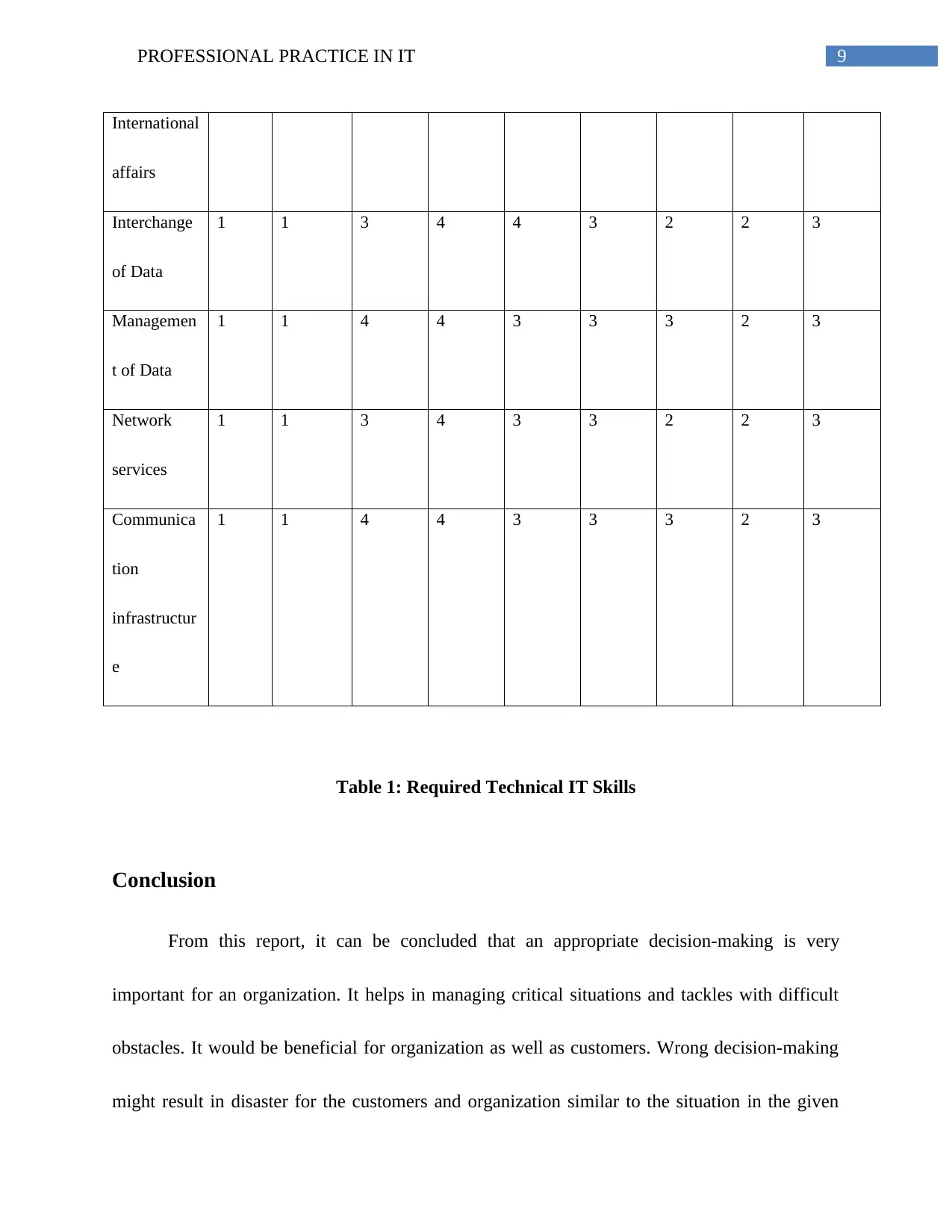
9PROFESSIONAL PRACTICE IN IT
International
affairs
Interchange
of Data
1 1 3 4 4 3 2 2 3
Managemen
t of Data
1 1 4 4 3 3 3 2 3
Network
services
1 1 3 4 3 3 2 2 3
Communica
tion
infrastructur
e
1 1 4 4 3 3 3 2 3
Table 1: Required Technical IT Skills
Conclusion
From this report, it can be concluded that an appropriate decision-making is very
important for an organization. It helps in managing critical situations and tackles with difficult
obstacles. It would be beneficial for organization as well as customers. Wrong decision-making
might result in disaster for the customers and organization similar to the situation in the given
International
affairs
Interchange
of Data
1 1 3 4 4 3 2 2 3
Managemen
t of Data
1 1 4 4 3 3 3 2 3
Network
services
1 1 3 4 3 3 2 2 3
Communica
tion
infrastructur
e
1 1 4 4 3 3 3 2 3
Table 1: Required Technical IT Skills
Conclusion
From this report, it can be concluded that an appropriate decision-making is very
important for an organization. It helps in managing critical situations and tackles with difficult
obstacles. It would be beneficial for organization as well as customers. Wrong decision-making
might result in disaster for the customers and organization similar to the situation in the given
Secure Best Marks with AI Grader
Need help grading? Try our AI Grader for instant feedback on your assignments.
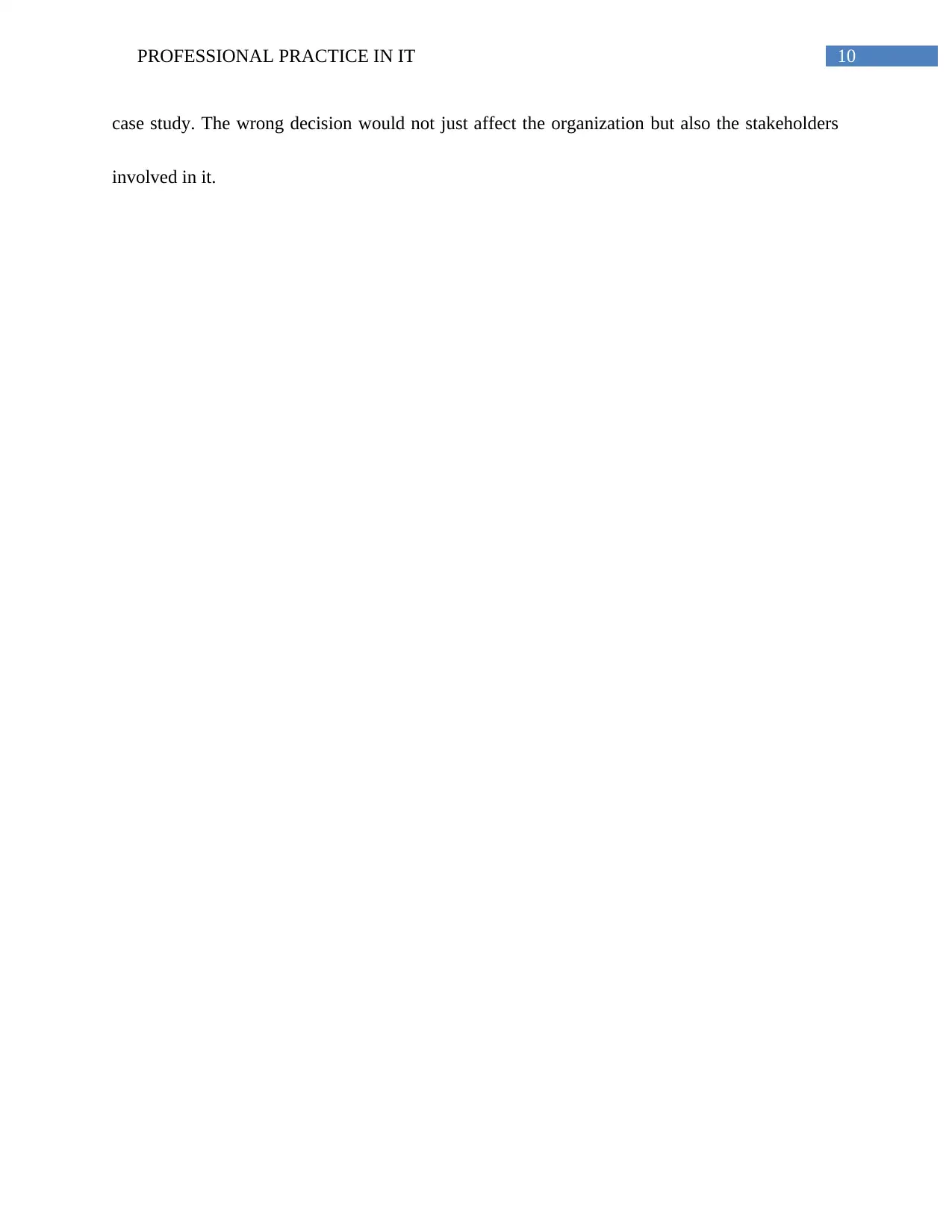
10PROFESSIONAL PRACTICE IN IT
case study. The wrong decision would not just affect the organization but also the stakeholders
involved in it.
case study. The wrong decision would not just affect the organization but also the stakeholders
involved in it.
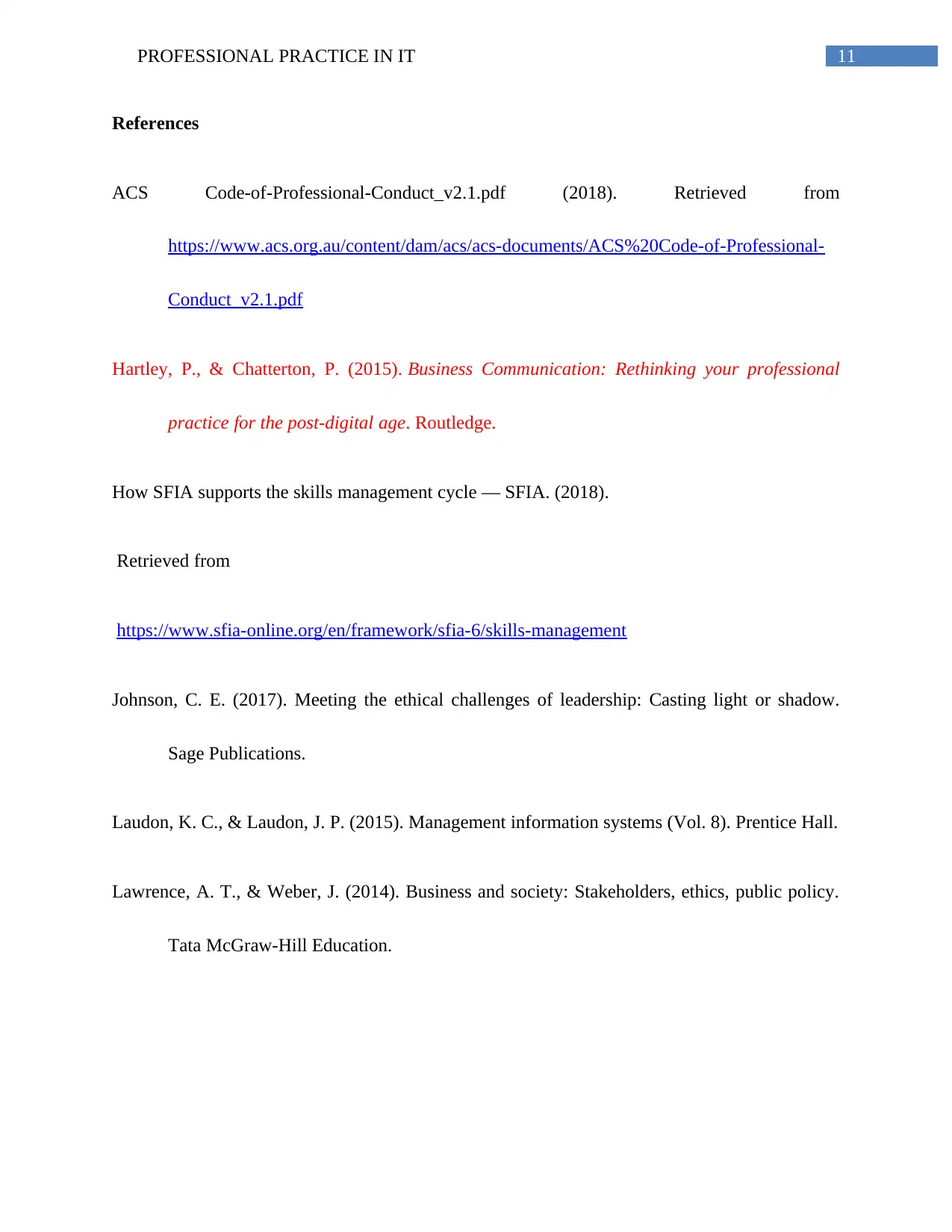
11PROFESSIONAL PRACTICE IN IT
References
ACS Code-of-Professional-Conduct_v2.1.pdf (2018). Retrieved from
https://www.acs.org.au/content/dam/acs/acs-documents/ACS%20Code-of-Professional-
Conduct_v2.1.pdf
Hartley, P., & Chatterton, P. (2015). Business Communication: Rethinking your professional
practice for the post-digital age. Routledge.
How SFIA supports the skills management cycle — SFIA. (2018).
Retrieved from
https://www.sfia-online.org/en/framework/sfia-6/skills-management
Johnson, C. E. (2017). Meeting the ethical challenges of leadership: Casting light or shadow.
Sage Publications.
Laudon, K. C., & Laudon, J. P. (2015). Management information systems (Vol. 8). Prentice Hall.
Lawrence, A. T., & Weber, J. (2014). Business and society: Stakeholders, ethics, public policy.
Tata McGraw-Hill Education.
References
ACS Code-of-Professional-Conduct_v2.1.pdf (2018). Retrieved from
https://www.acs.org.au/content/dam/acs/acs-documents/ACS%20Code-of-Professional-
Conduct_v2.1.pdf
Hartley, P., & Chatterton, P. (2015). Business Communication: Rethinking your professional
practice for the post-digital age. Routledge.
How SFIA supports the skills management cycle — SFIA. (2018).
Retrieved from
https://www.sfia-online.org/en/framework/sfia-6/skills-management
Johnson, C. E. (2017). Meeting the ethical challenges of leadership: Casting light or shadow.
Sage Publications.
Laudon, K. C., & Laudon, J. P. (2015). Management information systems (Vol. 8). Prentice Hall.
Lawrence, A. T., & Weber, J. (2014). Business and society: Stakeholders, ethics, public policy.
Tata McGraw-Hill Education.
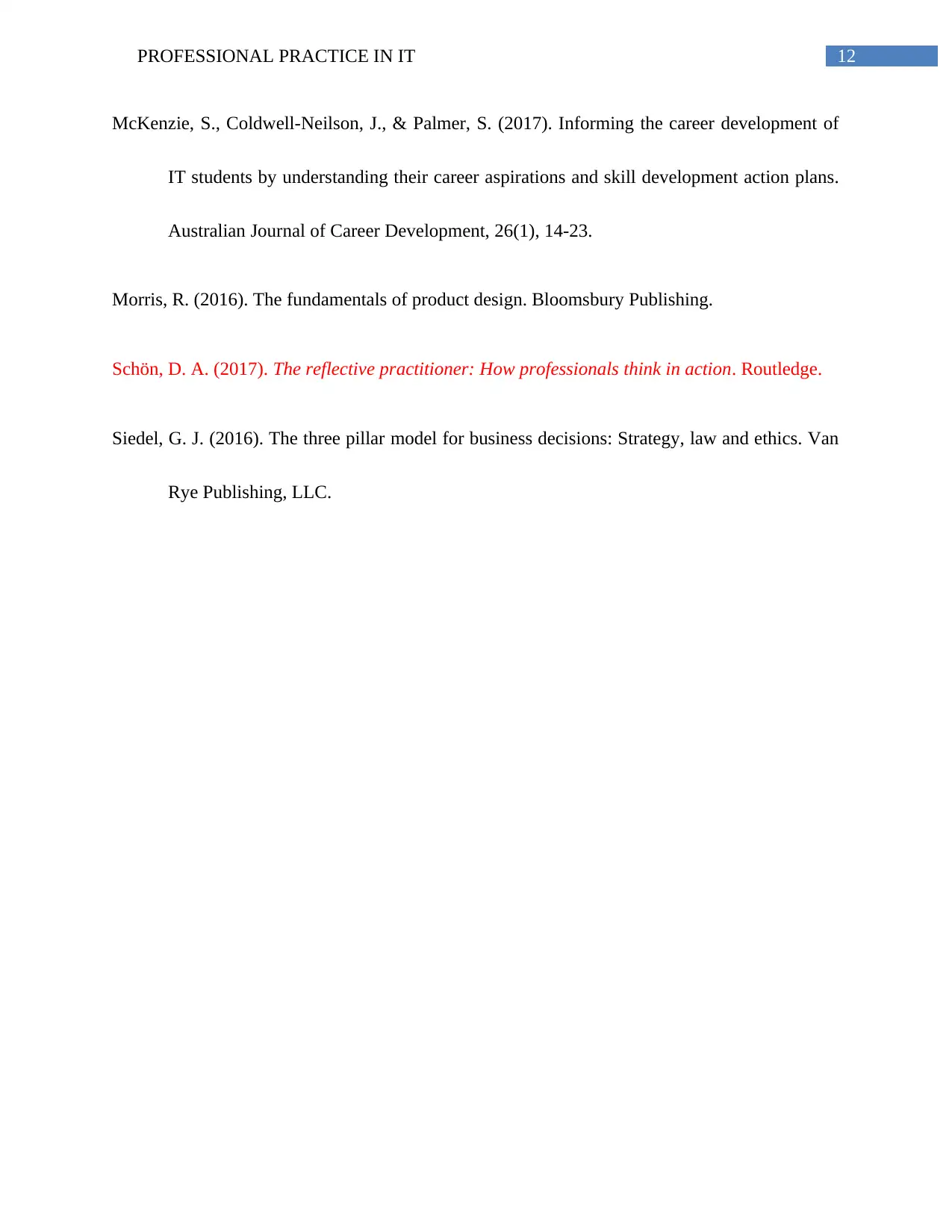
12PROFESSIONAL PRACTICE IN IT
McKenzie, S., Coldwell-Neilson, J., & Palmer, S. (2017). Informing the career development of
IT students by understanding their career aspirations and skill development action plans.
Australian Journal of Career Development, 26(1), 14-23.
Morris, R. (2016). The fundamentals of product design. Bloomsbury Publishing.
Schön, D. A. (2017). The reflective practitioner: How professionals think in action. Routledge.
Siedel, G. J. (2016). The three pillar model for business decisions: Strategy, law and ethics. Van
Rye Publishing, LLC.
McKenzie, S., Coldwell-Neilson, J., & Palmer, S. (2017). Informing the career development of
IT students by understanding their career aspirations and skill development action plans.
Australian Journal of Career Development, 26(1), 14-23.
Morris, R. (2016). The fundamentals of product design. Bloomsbury Publishing.
Schön, D. A. (2017). The reflective practitioner: How professionals think in action. Routledge.
Siedel, G. J. (2016). The three pillar model for business decisions: Strategy, law and ethics. Van
Rye Publishing, LLC.
1 out of 13
Related Documents
Your All-in-One AI-Powered Toolkit for Academic Success.
+13062052269
info@desklib.com
Available 24*7 on WhatsApp / Email
![[object Object]](/_next/static/media/star-bottom.7253800d.svg)
Unlock your academic potential
© 2024 | Zucol Services PVT LTD | All rights reserved.



